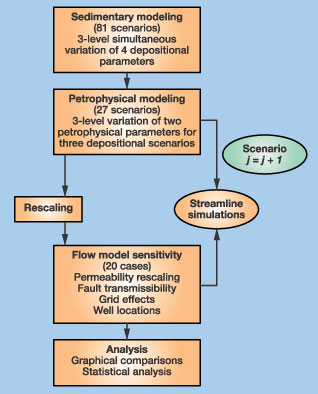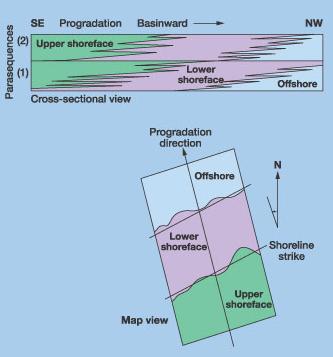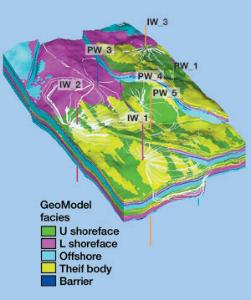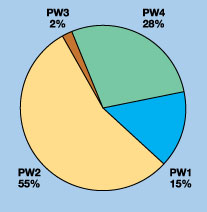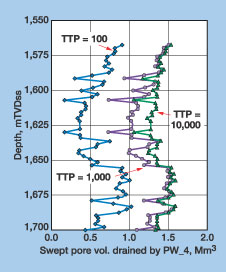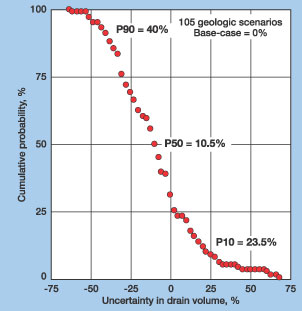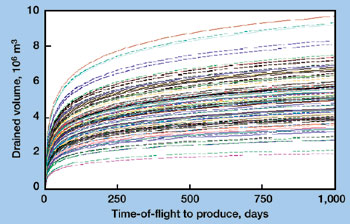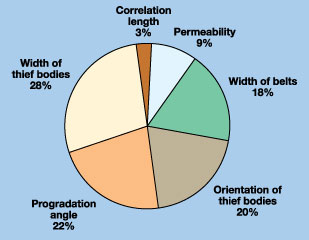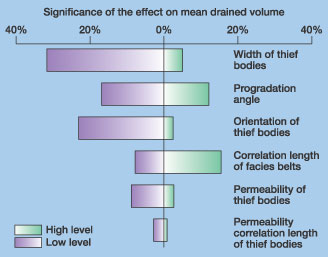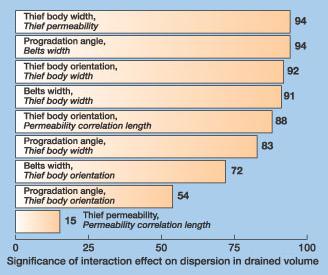Evaluating the uncertainty of 3-D geologic reservoir models
GEOLOGICAL/GEOPHYSICAL MODELINGEvaluating the uncertainty of 3-D geologic reservoir modelsThe workflow used to characterize and analyze a 3-D geologic reservoir model in a complex setting is described. The reservoir description primarily investigates flow and production behaviorAhmed Sharif and Dr. Alistair MacDonald, Roxar ASA, Norway
Results show that the workflow management used provides quick and early assessment of reservoir characteristics, from both geological and engineering perspectives. Three distinct advantages to this approach are:
Reservoir Uncertainty Considerations Reservoir characterization often is a complex task that may require detailed integration of all available data throughout the life of a field. At each stage of reservoir modeling, there is a certain degree of uncertainty associated with the model data and the description procedure. Since the nature of uncertainty is closely linked to available data, such uncertainty can be high at the appraisal stage due to limited data. However, prior models are updated as additional data are obtained. Reservoir characterization is thus a continuous process. At each stage, it is highly desirable to evaluate uncertainty and its impact upon reservoir performance. However, the detail in which reservoir uncertainty is explored may vary with the importance of the problem, scope of investigation and available resources (staff, facilities, time, etc.) This article presents a workflow-based procedure, illustrating an effective process that was employed to design, analyze, evaluate and rank reservoir uncertainty as an integral part of the reservoir characterization process. This process is saved as a series of interlinked tasks, and can be updated and modified to address different fields and data quantities, for example, whether seismic conditioning focuses the NPV distributions. Multiple reservoir scenarios were set up to explore the impact of depositional and petrophysical uncertainty upon reservoir performance. Fig. 1 presents the details of the workflow used. The focus was the effects of model parameters upon reservoir flow behavior and production performance. For this reason, the statistical variability associated with equally probable sets of realizations for a fixed geological model was of secondary importance. Furthermore, choosing to separate the specification of uncertainties in sedimentary and petrophysical models was done because the relationships connecting these uncertainties are generally unknown.1
By first constructing a base-case reservoir model, an experimental design was used to set up multiple reservoir scenarios by varying a number of key depositional and petrophysical parameters. Streamline simulations then were used to evaluate the flow characteristics and production performance of the reservoir models. Finally, analysis of both static and dynamic results were used to evaluate the credibility of the base-case model, compared to the set of alternative models produced by means of parametric uncertainty. Base-Case Reservoir Model The reservoir model consists of a complex setting, covering a 42.65-km2 (16.39-sq-mi) area. Depth to top of the reservoir model is 1,550 m (5,085 ft) and thickness is about 100 m (328 ft). The 3-D framework of the geologic model consists of 100 x 70 x 60 cells, a total of 4.2 million blocks. The sedimentary model comprises two shoreface parasequences, which generally prograded from south to north, resulting in the deposition of fine-grained, mud-rich facies in the north and coarser-grained, better reservoir rock in the south. A conceptual model of the depositional environment is shown in Fig. 2. Progradational geometries occur when the sediment supply exceeds the rate of creation of accommodation volume and facies belts migrate basinward.2 The parasequences are composed of three main facies belts – upper shoreface, lower shoreface and offshore. These belts occur in a systematic order and inter-finger. Within the widespread facies belts, two small-scale thief bodies and barriers were modeled. The thief bodies consist of high-permeability sheets of limited spatial extent, and are mostly restricted to the upper shoreface, while barriers are associated mostly with offshore and lower shore facies.
The sedimentary model was simulated using RMSgeoplex, part of Roxar’s IRAP RMS modeling suite. The facies belts were simulated using truncated Gaussian fields, with a trend in the expectation value to describe the direction of progradation and stacking, while an object model was used to distribute the small-scale heterogeneities. Table 1 presents key base case sedimentary input data. The petrophysical rock properties were stochastically modeled using well data and facies architecture. The key petrophysical data for the base-case model are presented in Table 2.
Uncertainty Scenarios The following parameters were selected to examine the impact of overall uncertainty attributed to the change of model parameters upon the static and dynamic characteristics of the base case model:
The first two parameters were chosen due to their impact upon the architecture of the vertical succession of parasequences and spatial continuity of facies tracts, as well as the degree of inter-fingering.3 The third and forth parameters were selected to examine dynamic effects of the sedimentary structure of small-scale, high-permeability thief bodies. The last two parameters were included in the analysis to evaluate the impact of uncertainty in petrophysical characteristics of these types of heterogeneities. The geologic scenarios were designed as follows:
Impact of Modeling Uncertainty Flow behavior and production performance of the geologic scenarios were evaluated using streamline simulations driven by RMSstream, a single-phase reservoir characterization module in the RMS suite. Essential input data include permeability and porosity for the various reservoir scenarios and specification of the perforation log. Three injection wells and four producers were used to study effects of rock heterogeneity on behavior of reservoir fluid flow and drainage of connected volume. Table 4 presents a summary of streamline simulation input. Fig. 3 depicts results of streamline simulation displayed with the base-case facies distribution.
The streamline simulations provided production data that characterizes inherent flow behavior of the multiple geologic scenarios. Data include connected volume drained by production well, swept volume associated with injectors, streamline breakthrough times and well allocation factors, e.g., fraction of injected fluid swept toward a given producer, Fig. 4.
Fig. 5 shows the evolution of drained volume as time-of-flight to producer (TTP) increases. As can be seen, the well drains most of the swept volume for TTP < 1,000, after which the increase in drained volume is not significant. Note, however, the presence of pockets of additional drained volume between TTP of 1,000 and 10,000.
Discussion of Results The cumulative probability of the uncertainty in pore volume is presented in Fig. 6, which shows the departure of pore volume associated with each scenario due to the perturbation of base-case depositional parameters. The spread is caused principally by the change of the progradation angle to a high and low level. It has been found that for lower progradation angle, pore volume decreases substantially. This probably is associated with less sediment deposition in the accommodation volume.
Simulated drained volume, as function of time-of-flight to producer, for the 105 geologic scenarios is given in Fig. 7. Fig. 8 shows effect of individual parameters on total uncertainty, without accounting for the interaction. These results indicate the strong impact of depositional fabric. The width of facies belts and progradation angle contribute to 50% of total uncertainty in the simulated drained volume. This manifests the sensitivity of the geologic model to an uncertainty in description of the spatial continuity and degree of inter-fingering.
Fig. 8 also shows the strong effect of uncertainty in thief body characterization. Despite the fact that these objects constitute less than 10% of the rock mass, width and orientation of these heterogeneities contribute to roughly 40% of the total uncertainty in drained volume. This probably is due to the impact of high permeability sheets upon the volumetric sweep within the shoreface facies tracts. For lower width values, for example, the thief bodies are thought to cause channeling, which might dramatically reduce sweep efficiency within the large shoreface bodies.
Fig. 9 presents the effect on mean drained volume attributed to the change of each individual parameter while remaining sensitivity parameters vary; whereas the impact of parameter interactions is explicitly given by Fig. 10, which presents the significance of the effect of parameter interactions upon the dispersion in drained volume. These results were produced using standard statistical techniques on the analysis of mean and variance distributions.6,7
The results indicate that the width of thief bodies, progradation angle of facies belts and the orientation of the thief bodies are the most influential geologic parameters for uncertainty in the reservoir model. Conversely, the petrophysical properties of the thief bodies were found much less significant than the thief body depositional character. The strong interaction between permeability and the width of thief bodies may, however, indicate a need for broader understanding of the relationship between sedimentary and petrophysical properties of the small-scale heterogeneities. Conclusions Despite the fact results presented in this article are restricted to the premise and approach of this study, the technique provides comprehensive characterization of reservoir rocks, which may also lend itself to straightforward extension to a wider analysis of geologic uncertainty. Reservoir uncertainty associated with rock heterogeneity can be comprehensively understood by examination of the impact of key model parameters upon the dynamic behavior of the geological model. The interaction between reservoir parameters can be an influential factor in reservoir performance. Evaluation of reservoir uncertainty therefore can be improved by studying the relationships between various depositional and petrophysical parameters. Dynamic characterization of fine-scale geologic models provides greater insight into the effects of rock heterogeneity on fluid flow and production performance. Hence, streamline solutions are, in this context, an advantageous tool in reservoir characterization. Geologic reservoir description and, in particular, evaluation and analysis of uncertainty, usually is resource-intensive (staff, time, facilities, etc.). The application of streamline-based solutions as an integral part of routine geologic workflows has the advantage that geoscientists can comprehensively obtain a dynamic dimension of the reservoir model without having expert knowledge in the details of the physics of multiphase fluid flow through reservoir rocks that typical reservoir simulations normally would require. This leads to better utilization of resources and will facilitate effective decision support. Traditionally, analysis of reservoir uncertainty has been done by studying the effect of key parameters on a one-at-a-time basis. Such a process is not only tedious and resource intensive, it may also lead to conclusions with limited scope. This is because the effect of a given model parameter (e.g., facies widths) may strongly depend upon the level of other model parameters. It is therefore important to design sensitivity workflows that allow the crossing effects of important parameter models. For this purpose, the accommodation of the analysis of reservoir uncertainty within the standard workflow of reservoir characterization will save both time and resources. In many cases, stochastic geologic modeling has been shown to support both better history match of field production and improved quantification of uncertainty in prediction of reservoir performance.8,9 Evaluation of the uncertainty in such detailed models needs to involve characterization of the dynamic aspects of the reservoir rock. Usually, however, flow simulations on coarse-scale reservoir models are employed to assess the impact of certain parameters upon the reservoir characteristics. Obviously, this is attractive computationally, but at best, it is a questionable workflow. This is because the upscaling process, which provides the transfer of rock attributes from detailed geologic model to coarse numerical blocks, is known to mask the details of rock heterogeneity. Furthermore, explicit analysis of the of impact of
varying certain lithological units cannot be done in the conventional scale of reservoir simulations.
Therefore, streamline solutions are more appropriate in that the dynamic behavior of detailed geologic models
can be integrated directly into the geologic description of the reservoir model. Thus, both static and dynamic
characteristics of given conceptual model(s) can be assessed conveniently before a final set of models are
passed to the engineers.
Literature Cited 1 Massonnat, G. J., "Sampling Space of Uncertainty Through Stochastic Modelling of Geological Facies," SPE 38746, SPE Annual Technical Conference and Exhibition, San Antonio, October 5 – 8, 1997. 2 Emery, D., and Myers, K. J., Sequence Stratigraphy, Blackwell, London (1996). 3 MacDonald, A. C., and Aasen, J. O., "A prototype Procedure for Stochastic Modelling of Facies Tract Distribution in Shoreface Reservoirs," Stochastic Modeling and Geostatistics, AAPG Computer Applications in Geology, Tulsa (1994), No. 3. 4 Damsleth, E., Hage, A., and Volden, R., "Maximum Information at Minimum Cost: A North Sea Field Development Study with an Experimental Design," Journal of Petroleum Technology, no. 12, (1992). 5 Egeland, T., Hatlebakk, E., Holden, L, and Larsen, E. A., "Designing Better Decisions," SPE 24275, SPE European Petroleum Computer Conference, Stavanger, Norway, May 25 – 27, 1992. 6 Weisberg, S., Applied Linear Regression, 2nd ed. Wiley, New York, (1985). 7 Press, W. H., Flannery, B. P., Teukolsky, S. A., and Vetterling, W. T., Numerical Recipes in FORTRAN: The Art of Scientific Computing, 2nd ed. Cambridge University Press, Cambridge, England (1992). 8 Rossini C., Brega F., Rovellini, M., and Spotti G., "Combined Geostatistical and Dynamic Simulations for Developing a Reservoir Management Strategy: A Case History," Journal of Petroleum Technology, Nov. 1994. 9 Suro-Perez, V., Ballin, P., Aziz, K., and Journel, A. G., "Modeling Geological Heterogeneities and Its Impact on Flow Simulation," SPE 22695 ATCE, Dallas (Oct. 1991)
|
||||||||||||||||||||||||||||||||||||||||||||||||||||||||||||||||||||||||||||||||||||||||||||||||||||||||||||||||||||||||||||||||||||||||||||||||||||||||||||||||||||||||||||
- Applying ultra-deep LWD resistivity technology successfully in a SAGD operation (May 2019)
- Adoption of wireless intelligent completions advances (May 2019)
- Majors double down as takeaway crunch eases (April 2019)
- What’s new in well logging and formation evaluation (April 2019)
- Qualification of a 20,000-psi subsea BOP: A collaborative approach (February 2019)
- ConocoPhillips’ Greg Leveille sees rapid trajectory of technical advancement continuing (February 2019)

